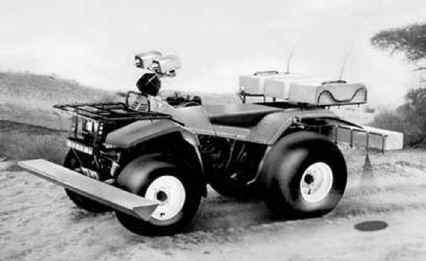
Remotely controlled means for humanitarian demining.
Batanov Alexander Fedorovich
Gritsynin Sergey Nikolaevich
Murkin Sergey Vladimirovich
REMOTELY CONTROLLED MEANS FOR HUMANITARIAN DEMINING
(based on materials from foreign sources)
The large-scale use of mines in local military conflicts has led to an unexpectedly dangerous result: a simple and long-familiar means of obstruction has turned into a delayed-action weapon of mass destruction.
According to rough UN estimates, more than 24,000 people die in minefields every year, and at least twice as many people are seriously injured, requiring long-term treatment and usually leading to amputation of limbs.
According to statistics from the International Red Cross, no more than 10% of victims are military personnel; the main victims of mine weapons are civilians, mainly women and children. Those who survive an encounter with a mine will never be able to play an active role in their family or society. Caring for the disabled is a heavy burden on their families.
Mass mining also causes significant material damage: vast tracts of land are taken out of agricultural use until they are completely cleared of mines; mines make refugees and displaced persons afraid to return home; the actual or suspected presence of mines prevents access to urgently needed resources and services, hinders economic recovery after a military conflict, and undermines normal socio-economic development.
Mass casualties among the civilian population during local armed conflicts as a result of anti-personnel mines (APM) have led to the creation of national and international public movements advocating for a complete ban and destruction of this type of weapon.
The most influential of these organizations, the International Campaign to Ban Mines, won the Nobel Peace Prize in 1997. Most European countries have completely removed anti-personnel mines from their armies.
These are the states that initiated the adoption of UN Resolution No. 48/75 in 1993, calling on all countries to introduce a moratorium on the export of anti-personnel mines; the adoption in May 1996 of Protocol II “On Prohibitions and Restrictions on the Use of Mines, Booby-Traps and Other Devices to the 1980 Geneva Convention on Prohibitions or Restrictions on the Use of Certain Conventional Weapons Which May Be Deemed to Be Excessively Injurious or to Have Indiscriminate Effects” (Inhumane Weapons Convention), as well as the negotiations and adoption of the Anti-Personnel Mine Ban Convention.
In a number of countries, mine production has been completely stopped and mine stockpiles are being gradually destroyed. Nevertheless, about a hundred specialized enterprises in 55 countries annually produce more than 10 million mines for export alone.
According to UN statistics, more than 110 million mines have already been installed in 69 countries. According to various estimates, 2 to 5 million munitions are installed annually, and only 100 thousand are removed.
As a result, the number of mines installed exceeds the number of mines destroyed.
It is impossible to radically speed up the mine clearance process using existing equipment.
Trained sappers survey vast territories decimeter by decimeter, while the productivity of one specialist is at most 50 m2 per day. In addition, the problem is not only in terms — the cost of defusing one mine is from $300 to $1000.
Third world countries, on whose territory the overwhelming majority of minefields are located, are not able to solve the problem of mine clearance on their own, since this requires large expenses.
The main efforts to organize and provide material support for the relevant activities are undertaken by the UN as part of the provision of humanitarian aid to underdeveloped countries.
Foreign experts note that it is possible to reduce the cost and increase the speed of searching, defusing and destroying modern mines only by developing new technical means, in particular, robotic systems.
When talking about robotic systems for mine clearance, it is necessary to clearly distinguish between:
— military systems;
— remote-controlled police robots for explosive work;
— robots for humanitarian mine clearance.
Military mine-clearing robots are designed to make passages in minefields under conditions of enemy fire resistance. Speed of movement is more important than the safety factor. As a rule, remotely controlled tanks equipped with track rollers or knife trawls are used for mine clearance. Destruction or removal of 80% of mines is considered acceptable.
Police robots are used to search for and destroy improvised explosive devices, usually in urban areas, and are extremely ineffective for demining large areas.
Robotic systems for humanitarian demining include a wide range of devices — from a set of standardized modules that turn an ordinary vehicle into a remote-controlled one, to fully autonomous mobile robots capable of independently, without human intervention, finding and destroying mines.
At present, the most developed are remotely controlled devices for searching for mines and clearing minefields. Work on creating autonomous robotic mine-sappers, carried out by numerous companies and research organizations, is at an early stage.
It should be noted that humanitarian demining is mainly associated with land-based anti-personnel mines, so the equipment offered by many companies is designed to destroy only anti-personnel mines and cannot be used against anti-tank, bottom, etc.
The following requirements are imposed on humanitarian demining devices:
— low cost;
— guaranteed safety for the operator;
— simple design, no need for fine-tuning or complex adjustments at the site of use;
— resistance to anti-personnel mine explosions, no serious damage from anti-tank mine explosions;
— maintenance by local personnel, using local materials;
— mobility – it is desirable that the device moves independently, without the use of auxiliary equipment;
— transportability.
The development of devices is carried out in two main directions – mine search and continuous demining of the area.
Searching for mines is a very difficult task. Modern mines are small in size and contain very little metal, which makes them almost impossible to detect using a standard induction mine detector.
The most reliable search method today is manual probing of the soil in 3 cm increments to a depth of 50 cm with a special probe. This method is slow, labor-intensive and extremely dangerous, but at present it is the only one that provides the 99.6% mine detection required by the UN.
Since mine detection is considered the most difficult part of the mine clearance process, much of the research and development work is aimed at improving it by automating the detection task, increasing the detection speed, improving the ability to distinguish mines from metal fragments, and protecting the operator.
In order to reduce material costs and development times, mine detection devices developed for industry and adapted for mine detection are used, in particular, non-linear radar, thermal imager, ultrasonic locator, chemical analyzer (“electronic nose”).
Developing equipment for searching is only part of the problem. It is very important to have a reliable and safe means for the operator to move the mine detector sensors over the surface of a minefield or mined road.
Remotely controlled vehicles have been developed and tested that can detect mines (so far only anti-tank mines) while moving along roads or slightly rugged terrain at a speed of up to 10 km/h.
Thus, the Israeli company ELTA Electronic Industries offers a remotely controlled vehicle with high cross-country ability, equipped with a non-linear radar and television cameras (photo 1*). In addition, the vehicle can be equipped with an induction mine detector and a thermal imager.
It is claimed that the vehicle is capable of detecting mines in both metal and plastic casings in a strip 2-3 m wide and at a depth of 0.3-15 m while moving at a speed of up to 4 m/s.
Wide wheels provide very low ground pressure, allowing the vehicle to move without the risk of being blown up by pressure mines with a trigger force of 700–2500 N.
Photo 1. Robotic mine search system
* The article uses photographs published on the Internet
Searching for mines using unmanned aerial vehicles is considered very promising.
Schiebel Technology has developed the Camcopter system, designed for minefield reconnaissance.
The Camcopter system includes:
- a small-sized remotely controlled helicopter (photo 2), equipped with a television camera and a ventral platform on which the necessary sensors are installed, such as a thermal imager;
- a ground control station, including flight control, navigation and platform control modules (photo 3).
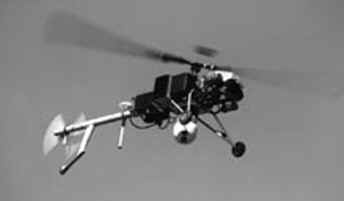
Photo 2. Small-sized remotely controlled helicopter Camcopter
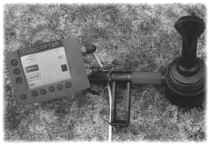 |
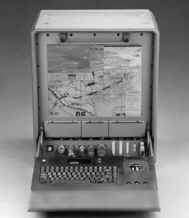 |
| a) flight control panel | b) control station monitor |
Photo 3. Camcopter helicopter control station
The Camcopter complex has a modular design and can be transported to the place of use in a passenger car. Only one person is needed to deploy the complex and control the helicopter.
The helicopter is made of lightweight, high-strength materials; its weight is 40 kg. A reliable two-stroke gasoline engine with a power of 15 hp provides a flight speed of 90 km/h, a climb speed of 185 m/min and a lift of 25 kg of payload to 1000 m. The maximum flight time is 6 hours, the range is 10 km.
The helicopter is controlled manually or automatically. With automatic control, the flight is carried out along a route pre-programmed at the control station. The operator controls the flight on the monitor and, if necessary, can interrupt the program, perform the necessary maneuvers in manual mode, and then return to automatic flight.
Stability on the route is ensured by an inertial navigation system, which contains a gyroscope, accelerometers and is connected to a receiver of signals from the global satellite positioning system (GPS – Global Positioning System).
The transceiver on board the helicopter receives control commands and continuously transmits data from reconnaissance equipment and the coordinates of the vehicle to the ground station.
The control station monitor screen constantly displays an image from the helicopter's built-in television camera and a digital map of the area being studied, which displays the current position of the aircraft, the programmed route, and reconnaissance data on the location of mine-like objects.
The operator analyzes the relative positions of the marks from the suspected mines and decides on the type of minefield, taking into account the features of laying minefields in various ways: from the air, by multiple launch rocket systems or manually. The final result of aerial reconnaissance is the precise geographic coordinates of the minefield.
The main advantage of aerial reconnaissance of minefields is high productivity and low cost.
The disadvantages include the practical impossibility of detecting 1-2 mines, since they can easily be confused with other objects located on the surface of the earth, and limited capabilities for detecting mines installed in the ground, since in this case the possibility of detection largely depends on how much the mine disturbs the surface cover.
Practice has shown that none of the devices used can be considered a panacea.
Currently, a number of research organizations are developing robotic systems for searching for mines, containing an array of sensitive elements based on different physical principles, ensuring reliable detection of mines of various designs;
a computing device for automatic interpretation and processing of data from sensors;
GPS receiver and geographic information system for displaying a map of the minefield and recording the coordinates of the found mines.
Continuous demining (in English-language sources the term clearance is used) means the removal, destruction or rendering harmless of mines and unexploded ordnance in order to prepare the land for economic use.
There are three main areas of development of robotic equipment for continuous demining:
- development of sets of instruments and devices that allow the conversion of serial minesweepers into robotic or remotely controlled systems;
- development on the basis of serial machines, with the maximum possible use of serial units and components, of universal robots equipped with a set of replaceable equipment;
- development of special robots designed to destroy a certain type of mine.
The fastest method of demining is considered to be using special mechanical devices – roller, knife and chain trawls.
These devices are designed to make passages in minefields and are not intended for clearing large areas. In addition, their operation requires powerful minesweeper machines, such as a tank or heavy tractor.
In order to take the driver outside the minefield and provide the possibility of automatic operation of the minesweeper, Omnitech Robotics International has developed the STS (Standardized Teleoperation System) remote control kit, which allows turning any vehicle into a robotic complex (photo 4).
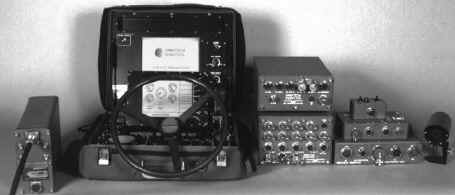
Photo 4. STS remote control kit
The kit includes two sets of modules. The modules of the first set — the antenna, control panel and radio transmitter of the emergency shutdown system — are located at the control post.
The second set, including an antenna, color video cameras on rotary devices, drives and a drive control unit, as well as mode switching units, video signal transmission, microphones and an emergency shutdown system receiver, is located on the machine.
STS provides:
- engine control (start and stop, speed control);
- braking;
- gear shifting;
- turning;
- control of the mounted trailer (lifting, lowering, tilting);
- feedback video and acoustic communication.
An important feature of the kit is the ability to maintain manual control of the machine. The transition from automatic to manual mode is carried out by simply switching the toggle switch.
More than 60 STS kits have already been installed.
Among the converted vehicles are Panther I and II minesweeper tanks used to clear minefields in Kosovo and Bosnia (photo 5), Caterpillar D7G heavy tractors (photo 6), Hummer multi-purpose vehicles and M9 armored engineering vehicles.
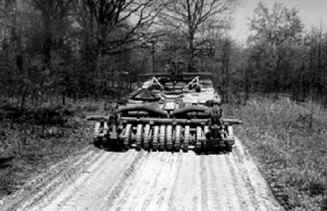
Photo 5. Panther II minesweeper tank equipped with a roller minesweeper
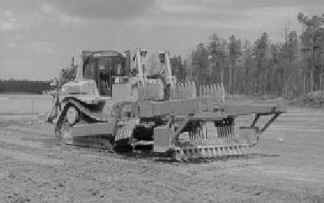
Photo. 6. Remote controlled Caterpillar D7R tractor equipped with a blade trawl
By order of the US Department of Defense, within the framework of the scientific research program for humanitarian demining, a remotely controlled vehicle for removing mines and unexploded ordnance, ETODS (Enhanced Teleoperated Ordnance Disposal System), was developed.
This robotic complex is designed to clear minefields that have already been surveyed in cases where the use of heavy equipment is impossible or impractical.
ETODS is based on a compact Bobcat front loader. The vehicle weight without attachments is 2045 kg. A 30 hp diesel engine provides a travel speed of up to 10 km/h.
The complex is used to:
- dig up and transport anti-tank mines and unexploded ordnance to the destruction site;
- destroy anti-personnel mines;
- mow grass and bushes in old minefields.
Each job has its own set of attachments.
Grass and bushes are removed using a retractable mower (photo 7). The mower's 102 cm wide cutting head is mounted on a special manipulator, which makes it possible to mow vegetation at a distance of up to 2.6 m from the machine.
In the event of a mine explosion, only the mower will be damaged, and the machine itself will remain intact.
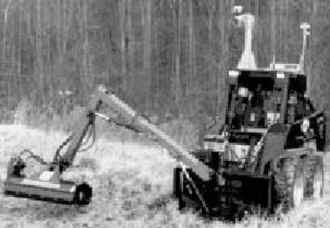
Photo 7. ETODS equipped with a retractable mower
Anti-personnel mines are destroyed by a mounted chain trawl with a sweep width of 178 cm. To protect the robot from fragments, armor plates are hung on the hull (photo 8).
Field tests have shown that the machine can withstand a mine explosion with a charge of 0.45 kg of TNT without harm.
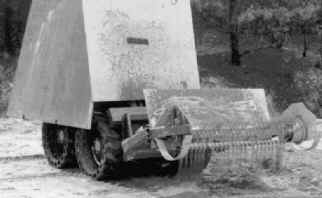
Photo 8. ETODS, chain trawl
To dig out anti-tank mines, the vehicle is equipped with:
- a manipulator with replaceable working equipment (a gripping device and a bucket);
- an Air Knife device for removing soil with a jet of compressed air;
- a mine detector with a marker for specifying the location of a buried mine (photo 9).
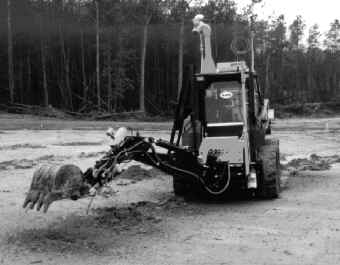
Photo 9. ETODS in mine-digging configuration
The general procedure for mine-digging is as follows:
1. The remote control post is deployed at the minefield boundary. If movement across the field is expected using GPS, the coordinates of the control post GPS receiver are entered into the control system. The location of the mines must be marked somehow — by coordinates on a minefield map, flags or colored marks on the field itself.
2. Before starting work, the operator installs the necessary equipment on the vehicle — a manipulator with a bucket or gripping device, an air knife and a mine detector.
3. When moving to the work site, the operator controls the vehicle using a surveillance camera installed on the vehicle body.
The machine is equipped with a DGPS system (a GPS receiver with differential corrections), and during movement the robot's current coordinates are displayed on the control post monitor. If the coordinates of the mine's location are known, then using DGPS, the operator can take the machine to a specified location with an accuracy of up to 1 m.
4. Before digging out a mine, the operator uses a mine detector to clarify its location. Then, compressed air is used to blow off the top layer of soil from the mine's surface. This must be done to determine the shape of the mine and its position in the ground. Otherwise, when digging out, the operator can place the bucket directly on the mine and detonate it.
5. After determining the exact location of the mine, the operator uses a bucket to extract it from the ground.
6. The dug out mine is transported to the place of destruction or neutralization. For this, the manipulator bucket is replaced with a gripping device. The operator monitors the work using television cameras installed on the manipulator and the vehicle body.
On average, it takes 5 minutes to extract one anti-personnel mine, and 10 minutes for an anti-tank mine.
To clear open, slightly rugged terrain (agricultural fields) from anti-personnel mines, the University of Edinburgh (UK) developed a machine of an unusual design (photo 10).
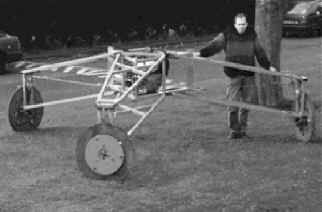
Photo 10. Remotely controlled vehicle Dervish
The machine (called Dervish) is a regular three-pointed star in plan. The power unit and control system are located in the center of the star.
At the ends of the beams are wheels — heavy (80 kg) steel disks 6 cm thick — driven by compact hydraulic motors. If the wheels rotate at the same speed, the machine simply spins in place.
The speed mismatch causes the machine to move, describing a spiral 5 m wide with a step of only 3 cm.
When moving, Dervish detonates anti-personnel mines, simulating the pressure of a human foot. In one minute, the machine's wheels process 5 m2, which is 1000 times faster than manual demining.
The vehicle's survivability is extremely high. Dervish, designed to detonate anti-personnel mines with a charge of up to 0.25 kg of TNT, withstands the explosion of an anti-tank mine with a charge of 5 kg with minimal damage.
One operator can control several vehicles by radio from a distance of 400 m.
While driving, a map of the area, vehicle trajectories, and the cleared area are displayed on the control panel monitor.
None of the robotic means proposed for humanitarian demining fully meets the requirements, and above all, in terms of efficiency — mechanical minefield cleaning means remove no more than 80% of mines, while 99.6% is required.
Nevertheless, this is better than nothing, and, according to foreign experts, robotic systems will provide significant assistance to sappers.
Note.
Mine clearance equipment is very expensive (for example, a simple Dervish costs $16,000, a universal ETODS costs $280,000, and a remote-controlled heavy tractor with the appropriate attachments can cost over $1.5 million).
The article uses materials published on the Internet. Additional information can be found at the following addresses:
1. Official UN documents – un.org/russian/documen/
2. The Humanitarian Demining Research Program; catalog of equipment for humanitarian demining demining.brtrc/R&D/
3. The U.S. State Department’s report “Hidden Killers: The Global Landmine Crisis” – state.gov/www/global/arms/rpt_9809
4. Statistical data on the problem of landmines – eagle.uccb.ns.ca/demine/problem.html
5. Devices for demining, description of the principle of operation – ukdf.org.uk/fs22.htm
6. ETODS and other robots from OAO — oao/robotics
7. Remote control kits from Omnitech Robotics – omnitech
8. Description of the Dervish robot — dervish.org

Добавить комментарий